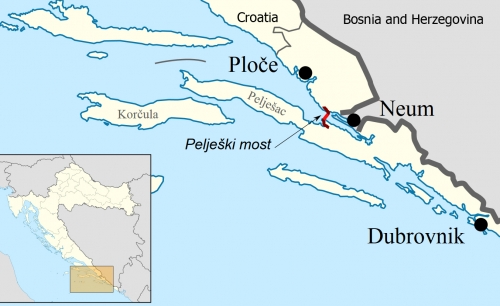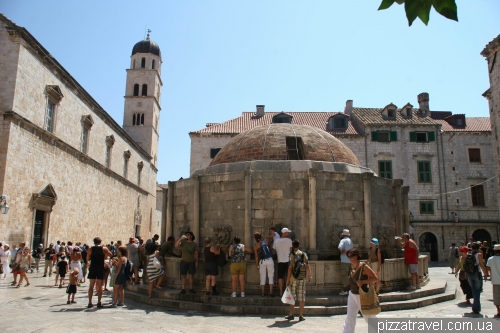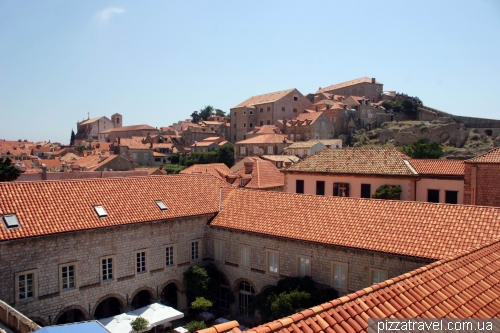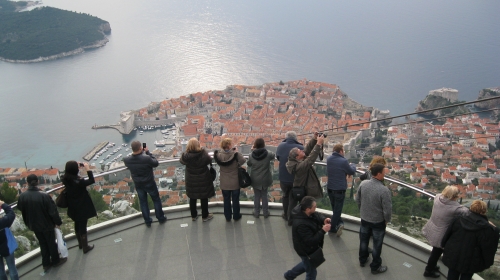Dubrovnik, along with Plitvice lakes, is the jewel of Croatia and all Adriatic. The city is situated in the southernmost part of Croatia and. Curiously, at the moment (2014) it is impossible to reach Dubrovnik through the territory of Croatia. Everyone have to cross Bosnia and Herzegovina border, which overlooks the sea. This is clearly seen on the following image.
Red line is a future Pelješac Bridge which is now under construction. With the help of it Croats plan finally connect Dubrovnik with the country. But since 2012 the construction stopped, the main reasons are political (Bosnia and Herzegovina) and economical. Latest news say that construction will continue in 2015.
Dubrovnik is located in a very beautiful location on the hillside.
But the city itself is not very interesting and most tourists come to walk in the Old Town, which was formed in the XVII century. Since 1979 is included in the list of UNESCO World Cultural Heritage Sites. It is quite large and hides behind a huge defensive wall. It is possible to walk on the wall around the city (about 2 km).
In 1667 the old city was destroyed by an earthquake and later rebuilt, but the most tragic time came in 1991. Croatia declared independence and the Yugoslav army began bombing of the city, which lasted for more than six months. On the following map you can see that most of the buildings were damaged or destroyed.
After the war, the Croatian authorities in cooperation with UNESCO regained most of the city. However, during our walk in 2008 there were still destroyed houses in several parts of the Old Town.
Dubrovnik is mainly situated on the cliffs, but the city has several small beaches. Tourists manage to swim under the walls of the old city.
From the main gate tourists get on the main street - Stradun. Its length is about 300 meters and it is the main street since the 12th century. Generally, there are a lot of visitors in Dubrovnik, so it is good idea to come earlier.
At both ends of the street are the fountains of the XV century.
The old town looks great from any location.
In addition to the Old Town there visit also the observation deck on the mountain with a funny name Srd, which offers a good view of the city. Top can be reached on foot (60-90 minutes from the old town) or by cable car (schedule and prices). The lower station is located in 100 meters from the city walls.
Unfortunately most of the time the sun is above the sea, so in front of your eyes. Use suncalc.net, to clarify the position of the sun, but in any case the best time for a visit early in the morning when you can climb only on foot.
More photos of Dubrovnik:
Map with tourist routes
Getting there: There is an airport, located 22 kilometers from the center. From the airport to the city run buses of Croatia Airlines ($6.5, 45 minutes). Taxi from the airport costs $50-60. Kantafig bus station is 2.5 kilometers from the Old Town. The nearest railway station is in Ploče, too far away.
Buses are available from all major cities in Croatia: Zagreb ($42, 11 hours, 7 times a day), Korcula ($18, 3 hours, 1 per day), Mostar ($18, 3 hours, 2 times a day), Orebic ($18, 2.5 hours, 1 per day), Rijeka ($72, 12 hours, 3 times a day), Sarajevo ($29, 5 hours, 1 per day), Split ($18-24, 4.5 hour, 14 times a day), Zadar ($36, 8 hours, 7 times a day). There are also buses from Montenegro cities which are located closer than most of the cities in Croatia. Do not forget that you will cross the border of Bosnia and Herzegovina, so a passport is required.
There is a port for cruise ships in Dubrovnik. The old town can be reached by buses 1, 1A and 1B. On the ferry www.jadrolinija.hr you can come from Rijeka, Split, Stari Grad, Korčula, Sobra and Bari (Italy).


























